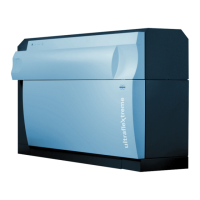
Do you have a question about the Bruker ultraflex Series and is the answer not in the manual?
| Resolution | > 20, 000 FWHM |
|---|---|
| Laser | Nitrogen laser (337 nm) |
| Applications | Proteomics, polymer analysis, imaging |
| Laser Wavelength | 337 nm |
| Ion Source | MALDI |
| Vacuum System | Turbo molecular pump |
| Accuracy | < 50 ppm (external calibration), < 10 ppm (internal calibration) |
| Technology | MALDI-TOF (Matrix-Assisted Laser Desorption/Ionization Time-of-Flight) |
Information on copyright, reproduction rights, and reserved rights.
Details revisions, publication dates, and warranty information provided by Bruker.
Policy on trademark usage and disclaimers regarding material and software.
Explains the meaning of the general triangular warning symbol.
Defines various hazard symbols used in documentation and on the instrument.
Presents symbols for sharp objects, moving parts, magnetic field, cryo gas, biohazard, entrapment, gas bottles, laser, suffocation.
Explains the structure and purpose of Warning, Caution, and Note messages.
Records the revision history of the manual, including dates and changes.
Covers general safety, instrument liability, and qualified personnel requirements.
Emphasizes following maintenance schedules and procedures correctly.
Details specific warnings for laser radiation, chemical burns, and electric shock.
Addresses biological hazards during cleaning and slip risks from spills.
Provides critical safety information regarding Class 4 laser product options.
Highlights laser warning label and safety note specific to the source heater.
Explains how application type affects cleaning intervals for LC-MALDI and Imaging.
Discusses how contamination affects performance and the need for cleaning.
Lists essential tools and materials for performing the cleaning procedures.
Guides on preparation steps and safely switching off the instrument via key-switch.
Shows control panel states and operation for switching the instrument off and removing the key.
Warns about electric shock and describes managing the cover lid and lift rod.
Details how to activate the top cover lift buttons using the rear panel key switch.
Illustrates rear panel connections and the top cover lift/enable key switch.
Guides on lifting the top cover and safely disconnecting the mains power cable.
Provides steps for safely opening the source chamber door using an Allen key.
Identifies key components within the source chamber, like laser mirror and HV cables.
Identifies ion optics components such as ion optic lens, P1 shield, and plates.
Warns about chemical and biological hazards and mandates appropriate PPE.
Provides general rules for cleaning optical and metal parts, including direction and tool usage.
Explains how contamination affects laser energy and how to clean optical parts.
Describes the procedure for cleaning the laser lens using swabs and ethanol.
Explains how to clean ion optic mirrors and the ion optic laser mirror.
Details the process for cleaning mirrors and lenses of the camera and illumination optics.
Guides on cleaning the P2 plate and ground plate using brushes and ethanol.
Illustrates flushing the P2 plate from the front, rear, and viewing the process.
Shows how to brush the P2 plate and between plates, emphasizing gentle pressure.
Covers drying parts with nitrogen and final inspection of the P2 plate.
Instructions to verify that HV cables (Lens, P2, P1-shield) are correctly connected.
Details on checking and cleaning the O-ring seal before closing the source door.
Steps to reconnect the P1 connector and secure the source door with screws.
Details on reconnecting power, switching on, pinch hazard warning, and key removal.
Guides on starting pumps and monitoring vacuum status via flexControl.
Notes the time required to restore vacuum and for the system to be ready for use.